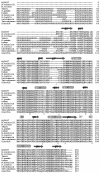Crystal structure of a fibrillarin homologue from Methanococcus jannaschii, a hyperthermophile, at 1.6 A resolution
- PMID: 10654930
- PMCID: PMC305568
- DOI: 10.1093/emboj/19.3.317
Crystal structure of a fibrillarin homologue from Methanococcus jannaschii, a hyperthermophile, at 1.6 A resolution
Abstract
Fibrillarin is a phylogenetically conserved protein essential for efficient processing of pre-rRNA through its association with a class of small nucleolar RNAs during ribosomal biogenesis. The protein is the antigen for the autoimmune disease scleroderma. Here we report the crystal structure of the fibrillarin homologue from Methanococcus jannaschii, a hyperthermophile, at 1.6 A resolution. The structure consists of two domains, with a novel fold in the N-terminal region and a methyltransferase-like domain in the C-terminal region. Mapping temperature-sensitive mutations found in yeast fibrillarin Nop1 to the Methanococcus homologue structure reveals that many of the mutations cluster in the core of the methyltransferase-like domain.
Figures








Similar articles
-
Expression, purification and preliminary X-ray analysis of a fibrillarin homolog from Methanococcus jannaschii, a hyperthermophile.Acta Crystallogr D Biol Crystallogr. 1999 Jan;55(Pt 1):338-40. doi: 10.1107/S0907444998007513. Epub 1999 Jan 1. Acta Crystallogr D Biol Crystallogr. 1999. PMID: 10089444
-
High-resolution structure of eukaryotic Fibrillarin interacting with Nop56 amino-terminal domain.RNA. 2021 Apr;27(4):496-512. doi: 10.1261/rna.077396.120. Epub 2021 Jan 22. RNA. 2021. PMID: 33483369 Free PMC article.
-
A yeast nucleolar protein related to mammalian fibrillarin is associated with small nucleolar RNA and is essential for viability.EMBO J. 1989 Dec 20;8(13):4015-24. doi: 10.1002/j.1460-2075.1989.tb08584.x. EMBO J. 1989. PMID: 2686980 Free PMC article.
-
Structure of a two-domain N-terminal fragment of ribosomal protein L10 from Methanococcus jannaschii reveals a specific piece of the archaeal ribosomal stalk.J Mol Biol. 2010 Jun 4;399(2):214-20. doi: 10.1016/j.jmb.2010.04.017. Epub 2010 Apr 24. J Mol Biol. 2010. PMID: 20399793 Review.
-
Nucleolar Methyltransferase Fibrillarin: Evolution of Structure and Functions.Biochemistry (Mosc). 2016 Sep;81(9):941-50. doi: 10.1134/S0006297916090030. Biochemistry (Mosc). 2016. PMID: 27682166 Review.
Cited by
-
Box C/D sRNA stem ends act as stabilizing anchors for box C/D di-sRNPs.Nucleic Acids Res. 2016 Oct 14;44(18):8976-8989. doi: 10.1093/nar/gkw576. Epub 2016 Jun 24. Nucleic Acids Res. 2016. PMID: 27342279 Free PMC article.
-
Nucleolonema as a fundamental substructure of the nucleolus.J Plant Res. 2005 Apr;118(2):71-81. doi: 10.1007/s10265-005-0204-8. Epub 2005 Apr 21. J Plant Res. 2005. PMID: 15843864 Review.
-
Methyl-RNA: an evolutionary bridge between RNA and DNA?Chem Biol. 2000 Dec;7(12):R207-16. doi: 10.1016/s1074-5521(00)00042-9. Chem Biol. 2000. PMID: 11137821 Free PMC article.
-
Colocalization and interaction of the porcine arterivirus nucleocapsid protein with the small nucleolar RNA-associated protein fibrillarin.J Virol. 2003 Nov;77(22):12173-83. doi: 10.1128/jvi.77.22.12173-12183.2003. J Virol. 2003. PMID: 14581554 Free PMC article.
-
Human box H/ACA pseudouridylation guide RNA machinery.Mol Cell Biol. 2004 Jul;24(13):5797-807. doi: 10.1128/MCB.24.13.5797-5807.2004. Mol Cell Biol. 2004. PMID: 15199136 Free PMC article.
References
-
- Brünger A.T. (1992a) X-PLOR Version 3.1. A System for Crystallography and NMR. Yale University Press, New Haven, CT.
-
- Brünger A.T. (1992b) The free R value: a novel statistical quantity for assessing the accuracy of crystal structures. Nature, 335, 472–475. - PubMed
Publication types
MeSH terms
Substances
Associated data
- Actions
LinkOut - more resources
Full Text Sources
Molecular Biology Databases
Research Materials

